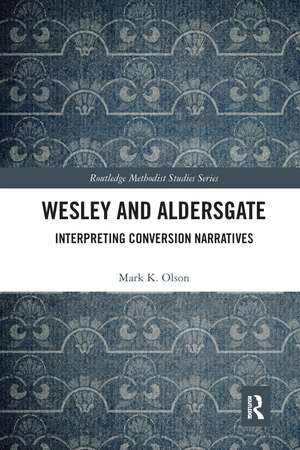Wesley and Aldersgate: Interpreting Conversion Narratives: Routledge Methodist Studies Series
Autor Mark K. Olsonen Limba Engleză Paperback – 30 iun 2020
The central aim of this study is to establish Wesley’s interpretation of his Aldersgate experience as it developed from its initial impressions on the night of 24 May 1738 to its mature articulation in the 1770s. By paying close attention to the language of his diaries, letters, journals, sermons, tracts and other writings, fresh insights into Wesley‘s own perspective are revealed. When these insights are brought into wider context of other conversion narratives in the Christian milieu in which Wesley worked and wrote, this book demonstrates that this single event contributed in significant ways to the ethos of the Methodist movement, and many other denominations, even up to the present day.
This is a unique study of the conversion of one of history’s most influential Christian figures, and the impact that such narratives still have on us today. As such, it will be of great use to scholars of Methodism, theology, religious history and religious studies more generally.
Din seria Routledge Methodist Studies Series
-
 Preț: 401.92 lei
Preț: 401.92 lei -
 Preț: 295.82 lei
Preț: 295.82 lei -
 Preț: 311.41 lei
Preț: 311.41 lei -
 Preț: 311.41 lei
Preț: 311.41 lei -
 Preț: 385.47 lei
Preț: 385.47 lei - 25%
 Preț: 324.16 lei
Preț: 324.16 lei -
 Preț: 436.14 lei
Preț: 436.14 lei -
 Preț: 456.06 lei
Preț: 456.06 lei -
 Preț: 469.34 lei
Preț: 469.34 lei - 21%
 Preț: 258.42 lei
Preț: 258.42 lei - 21%
 Preț: 259.10 lei
Preț: 259.10 lei - 16%
 Preț: 312.43 lei
Preț: 312.43 lei -
 Preț: 386.13 lei
Preț: 386.13 lei -
 Preț: 385.47 lei
Preț: 385.47 lei -
 Preț: 384.81 lei
Preț: 384.81 lei -
 Preț: 383.50 lei
Preț: 383.50 lei - 26%
 Preț: 847.73 lei
Preț: 847.73 lei -
 Preț: 324.68 lei
Preț: 324.68 lei -
 Preț: 385.25 lei
Preț: 385.25 lei -
 Preț: 311.41 lei
Preț: 311.41 lei -
 Preț: 384.02 lei
Preț: 384.02 lei - 18%
 Preț: 1000.45 lei
Preț: 1000.45 lei -
 Preț: 310.81 lei
Preț: 310.81 lei - 18%
 Preț: 1000.13 lei
Preț: 1000.13 lei -
 Preț: 389.66 lei
Preț: 389.66 lei - 34%
 Preț: 758.56 lei
Preț: 758.56 lei
Preț: 256.78 lei
Preț vechi: 324.83 lei
-21% Nou
Puncte Express: 385
Preț estimativ în valută:
49.14€ • 51.11$ • 40.57£
49.14€ • 51.11$ • 40.57£
Carte tipărită la comandă
Livrare economică 14-28 aprilie
Preluare comenzi: 021 569.72.76
Specificații
ISBN-13: 9780367587437
ISBN-10: 0367587432
Pagini: 210
Dimensiuni: 156 x 234 x 17 mm
Greutate: 0.3 kg
Ediția:1
Editura: Taylor & Francis
Colecția Routledge
Seria Routledge Methodist Studies Series
Locul publicării:Oxford, United Kingdom
ISBN-10: 0367587432
Pagini: 210
Dimensiuni: 156 x 234 x 17 mm
Greutate: 0.3 kg
Ediția:1
Editura: Taylor & Francis
Colecția Routledge
Seria Routledge Methodist Studies Series
Locul publicării:Oxford, United Kingdom
Public țintă
Postgraduate and UndergraduateCuprins
Introduction: Interpreting Conversion Narratives 1 The Riddle of Aldersgate 2 The Sources of Aldersgate 3 The ‘Official’ Version: Part One 4 The ‘Official’ Version: Part Two 5 The ‘Unofficial’ Versions 6 The Corroborating Witnesses 7 The Legacy of Aldersgate Conclusion: Wesley and Aldersgate Appendix 1: References to Wesley’s Conversion Appendix 2: John Wesley’s Conversion in Parallel Accounts
Notă biografică
Mark K. Olson is Adjunct Faculty at Indiana Wesleyan University and Nazarene Bible College, both in the USA. He has published several books on Wesley including A John Wesley Reader on Eschatology (2011) and John Wesley’s Theology of Christian Perfection (2007) and multiple articles.
Recenzii
"Wesley and Aldersgate is a useful book for Methodist Studies scholars, as well as to Religion scholars and laypeople interested in conversion—for the latter—with the aid of some of the historical and theological works upon which Olson draws to fill in context."
- Natalya Cherry, Brite Divinity School, Reading Religion
"One of the persistent questions in Methodist Studies is how best to interpret Wesley's Aldersgate experience and its significance for those in the Wesleyan tradition. Olson's Wesley and Aldersgate (revised from his doctoral dissertation [University of Manchester]) provides a welcome addition to the body of literature addressing these questions."
- Elaine A. Robinson, Oklahoma City University
"This is a persuasive study, based on painstaking research. Olson has made a significant contribution to the literature of the founding narrative of methodism, and has helpfully located John Wesley's experience within the wider setting of eighteen century evangelicalism."
- Martin Wellings, Wesley and Methodist Studies
- Natalya Cherry, Brite Divinity School, Reading Religion
"One of the persistent questions in Methodist Studies is how best to interpret Wesley's Aldersgate experience and its significance for those in the Wesleyan tradition. Olson's Wesley and Aldersgate (revised from his doctoral dissertation [University of Manchester]) provides a welcome addition to the body of literature addressing these questions."
- Elaine A. Robinson, Oklahoma City University
"This is a persuasive study, based on painstaking research. Olson has made a significant contribution to the literature of the founding narrative of methodism, and has helpfully located John Wesley's experience within the wider setting of eighteen century evangelicalism."
- Martin Wellings, Wesley and Methodist Studies
Descriere
The central aim of this study is to establish Wesley’s interpretation of his Aldersgate experience as it developed from its initial impressions on the night of 24 May 1738 to its mature articulation in the 1770s.
